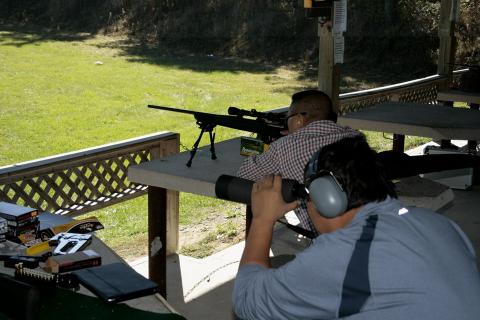
In Part I, The Dreaded Flinch we discussed what flinching is, what causes it, and how to avoid it. Now let’s deal with how to detect it and, more importantly, how to get rid of it.
Have you ever tried to fire your rifle at the range with the safety still on or the chamber empty? Sure, we all have. But did you find that you were yanking the trigger and closing your eyes in anticipation of the recoil, only to have absolutely nothing happen? Felt a bit silly, didn’t it? Well, if that happens to you, you have a flinch.
 |
| Have someone observe you just before you pull the trigger, watching for the telltale signs of a flinch. |
If you just suspect you may have a flinch, you can get a friend at the range to recreate the same scenario for you by letting them load your rifle for you while you are not looking. The trick is that sometimes they will actually load your rifle with a live round, and other times they will just chamber a snap cap or nothing at all. The point is that you don’t know, so you will be expecting the recoil every time. Ask your friend to carefully observe you just before you pull the trigger, watching for the telltale signs of a flinch described above, or to see if you are pulling your head or shoulder off the stock. Some of the signs of a flinch can be obscured during recoil, making it hard to self-diagnose, but they will be very evident to an observer when the only result of pulling the trigger is a metallic “click”.
If you determine you do have a flinch, don’t worry; recognizing you have a problem is always half the battle. Here are some things you can do to treat and hopefully even cure it.
- Take a Step Back. In Part I we discussed five things you can do to prevent a flinch. Just because you already have a flinch doesn’t mean it’s too late for these as remedial measures. Review those tips and implement any that you aren’t already doing.
- Downsize. The best treatment for anyone who has developed a sensitivity to recoil is to reduce the amount of recoil you are incurring. Specifically, switch to a smaller caliber. I’m a big fan of the 7mm and .30 caliber class of rounds, but you don’t need something that big for deer, or even much of North America’s big game species. Calibers such as the 6mm Remington, .243 Winchester, .257 Roberts and .25-06 Remington are more than adequate for deer-sized game, and produce significantly less felt recoil. Once you become comfortable shooting these lighter calibers without flinching, you can try to slowly and gradually work your way back up to the bigger rounds, but you may find that you enjoy shooting the .24 and .25 calibers so much and with so much success that you will choose to stick with them.
- Bulk Up. A lightweight rifle may be a joy to carry around all day, but the price to be paid is more felt recoil. This is a matter of simple physics: a light object is moved more easily (and with more velocity) with the same amount of energy (recoil) than a heavier object. Especially in .30 caliber or higher rounds, if your rifle doesn’t weigh about 8 pounds, you are going to feel a healthy amount of recoil. This is why large caliber “elephant guns” all weigh in excess of 10 pounds.
- Slow Down. Ammunition manufacturers are aware of the dreaded “F-word” too and have come up with some “reduced recoil” loads in recent years. These are simply loads that contain less or different powders, along with bullets designed to perform at lower velocities. The result is a round with a shorter effective range, but also up to 50% reduction in recoil. Some are suitable for hunting, and all are great for practising. If you are handloader, you can accomplish the same thing by producing your own “lighter” loads that still produce great accuracy and effective performance on deer-sized game.
- Visit Dr. Gunsmith. If these measures fail, a good gunsmith like Smith’s Custom Guns (www.smithscustomguns.com) can install devices such as a muzzle brake on your barrel or even a mercury recoil suppressor tube in your buttstock, both of which can significantly reduce the amount of felt recoil.
If you have developed a flinch, one or more of these tips should help you drop the “F-word” from your vocabulary.
Good shooting.
- 4282 views

